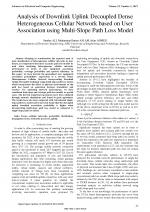| 2/2019 - 6 |
Analysis of Downlink Uplink Decoupled Dense Heterogeneous Cellular Network based on User Association using Multi-Slope Path Loss ModelALI, S. |
| Extra paper information in |
| Click to see author's profile in |
| Download PDF |
Author keywords
cellular networks, probability distribution, propagation losses, stochastic processes, uplink
References keywords
uplink(13), link(12), networks(11), communication(10), cellular(10), path(7), loss(7), communications(7), analysis(7), propagation(6)
Blue keywords are present in both the references section and the paper title.
About this article
Date of Publication: 2019-05-31
Volume 19, Issue 2, Year 2019, On page(s): 45 - 52
ISSN: 1582-7445, e-ISSN: 1844-7600
Digital Object Identifier: 10.4316/AECE.2019.02006
Web of Science Accession Number: 000475806300006
SCOPUS ID: 85066334149
Abstract
Keeping in consideration the expected need of node densification of heterogeneous cellular networks in near future, it is imperative that more accurate path loss models be used when analyzing heterogeneous cellular networks performance in terms of user equipment association probability, coverage probability and spectral efficiency. In this paper, we have derived the generalized user equipment association probabilities expressions of a two-tier Dense Heterogeneous Cellular Network incorporating Downlink Uplink Decoupled technique using multi-slope path loss model, which incorporates the effect of physical environment on the path loss based on separation between transmitter and receiver. For analyzing network performance, we have considered dual-slope and tri-slope path loss models as special cases. The derived analytical expressions have been validated through network simulations and found in good agreement. The results have also been compared with conventional single-slope path loss model and it has been found that the decoupled uplink downlink association probability is higher when incorporating multi-slope path loss model as compared to single-slope path loss model. |
| References | | | Cited By |
Web of Science® Times Cited: 3 [View]
View record in Web of Science® [View]
View Related Records® [View]
Updated 3 weeks, 2 days ago
SCOPUS® Times Cited: 6
View record in SCOPUS® [Free preview]
View citations in SCOPUS® [Free preview]
[1] Uplink Performance of Narrowband Internet-of-Things Devices in Downlink–Uplink Decoupled-Based Heterogeneous Networks, Ali, Sundus, Aslam, Muhammad Imran, Ahmed, Irfan, Khawaja, Attaullah, Iranian Journal of Science and Technology, Transactions of Electrical Engineering, ISSN 2228-6179, Issue 2, Volume 47, 2023.
Digital Object Identifier: 10.1007/s40998-022-00570-w [CrossRef]
[2] A New Effective Strategy for User Association in Heterogeneous Networks, Aziz, Layla, El Gourari, Abdelali, Achki, Samira, International Journal of Sensors, Wireless Communications and Control, ISSN 2210-3279, Issue 3, Volume 13, 2023.
Digital Object Identifier: 10.2174/2210327913666230601153113 [CrossRef]
[3] Impact of fractional power control on downlink uplink decoupled‐based HetNets in varying path loss exponent environment, Ali, Sundus, Imran Aslam, Muhammad, Ahmed, Irfan, Transactions on Emerging Telecommunications Technologies, ISSN 2161-3915, Issue 7, Volume 33, 2022.
Digital Object Identifier: 10.1002/ett.4491 [CrossRef]
[4] Analysis of the decoupled uplink downlink technique for varying path loss exponent in multi-tier HetNet, Ali, Sundus, Aslam, Muhammad Imran, Ahmed, Irfan, Khurshid, Tayyaba, Telecommunication Systems, ISSN 1018-4864, Issue 4, Volume 74, 2020.
Digital Object Identifier: 10.1007/s11235-020-00661-1 [CrossRef]
Disclaimer: All information displayed above was retrieved by using remote connections to respective databases. For the best user experience, we update all data by using background processes, and use caches in order to reduce the load on the servers we retrieve the information from. As we have no control on the availability of the database servers and sometimes the Internet connectivity may be affected, we do not guarantee the information is correct or complete. For the most accurate data, please always consult the database sites directly. Some external links require authentication or an institutional subscription.
Web of Science® is a registered trademark of Clarivate Analytics, Scopus® is a registered trademark of Elsevier B.V., other product names, company names, brand names, trademarks and logos are the property of their respective owners.
Faculty of Electrical Engineering and Computer Science
Stefan cel Mare University of Suceava, Romania
All rights reserved: Advances in Electrical and Computer Engineering is a registered trademark of the Stefan cel Mare University of Suceava. No part of this publication may be reproduced, stored in a retrieval system, photocopied, recorded or archived, without the written permission from the Editor. When authors submit their papers for publication, they agree that the copyright for their article be transferred to the Faculty of Electrical Engineering and Computer Science, Stefan cel Mare University of Suceava, Romania, if and only if the articles are accepted for publication. The copyright covers the exclusive rights to reproduce and distribute the article, including reprints and translations.
Permission for other use: The copyright owner's consent does not extend to copying for general distribution, for promotion, for creating new works, or for resale. Specific written permission must be obtained from the Editor for such copying. Direct linking to files hosted on this website is strictly prohibited.
Disclaimer: Whilst every effort is made by the publishers and editorial board to see that no inaccurate or misleading data, opinions or statements appear in this journal, they wish to make it clear that all information and opinions formulated in the articles, as well as linguistic accuracy, are the sole responsibility of the author.



